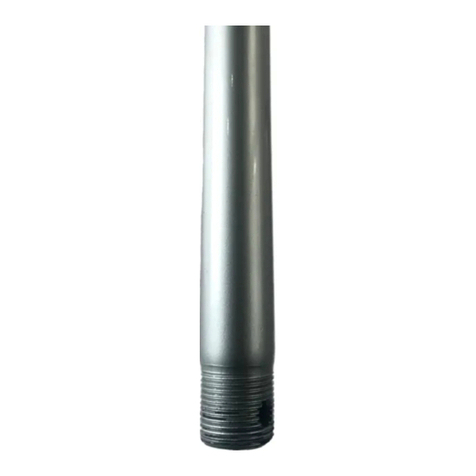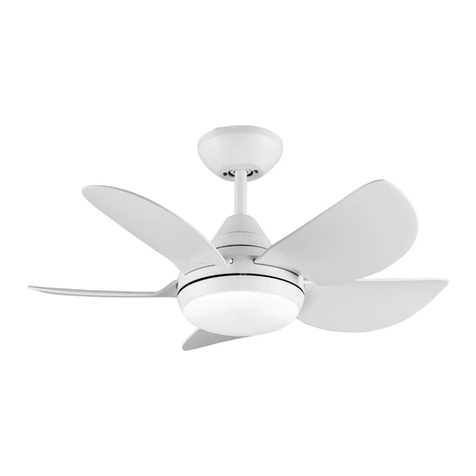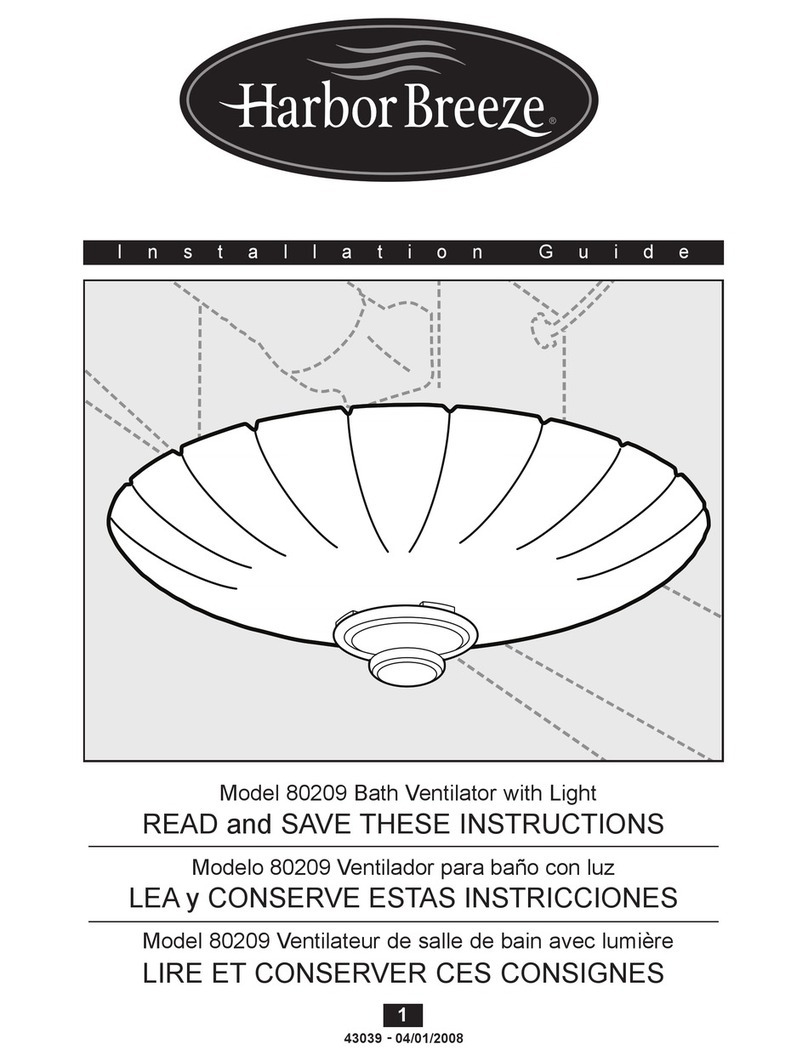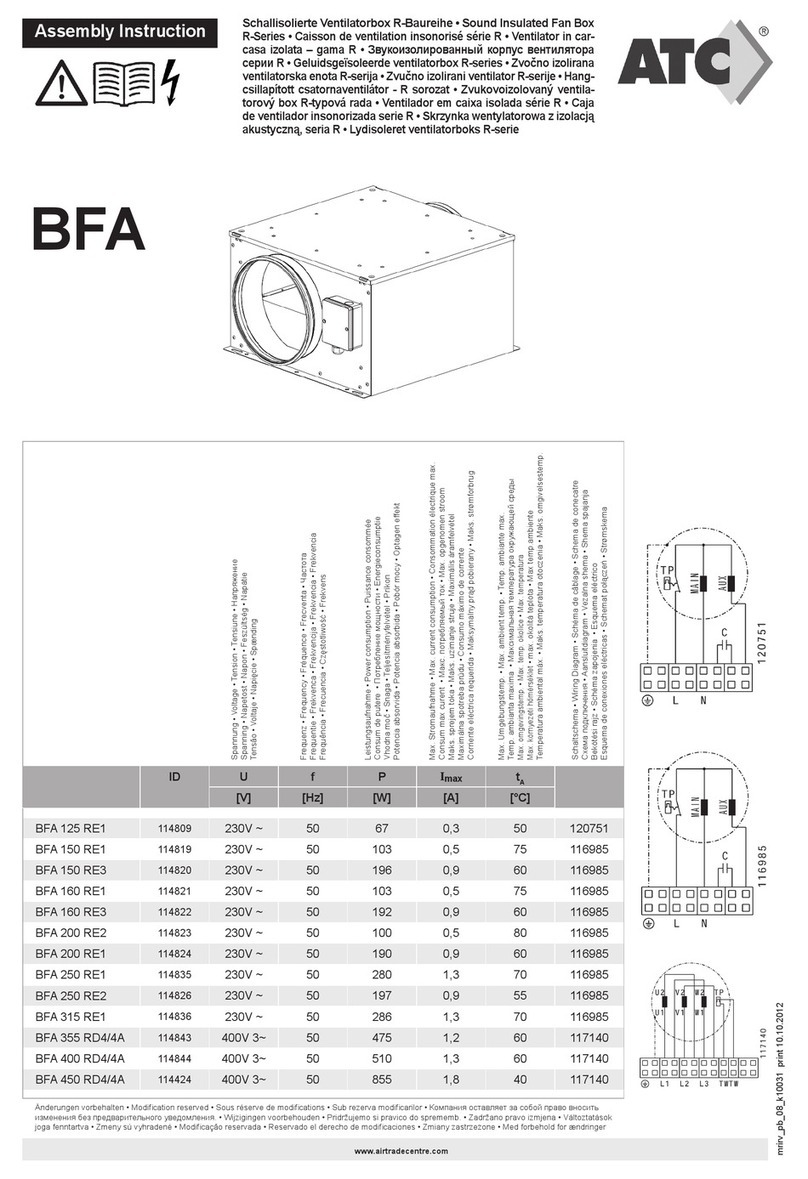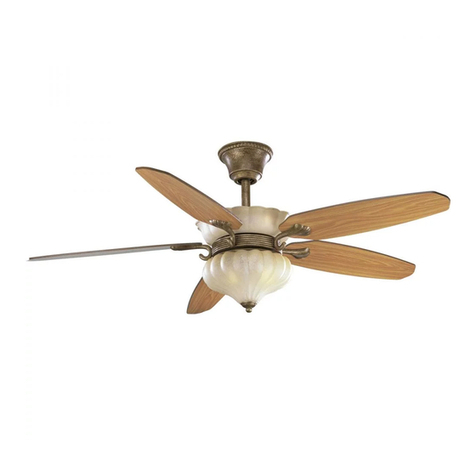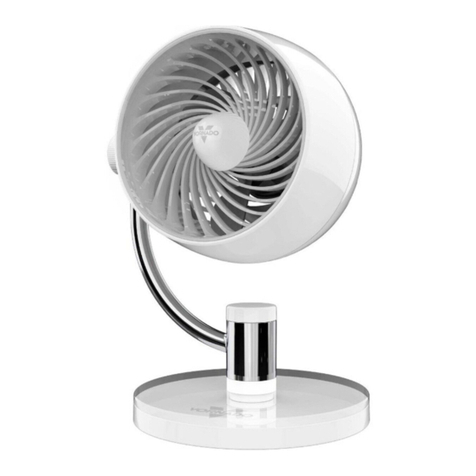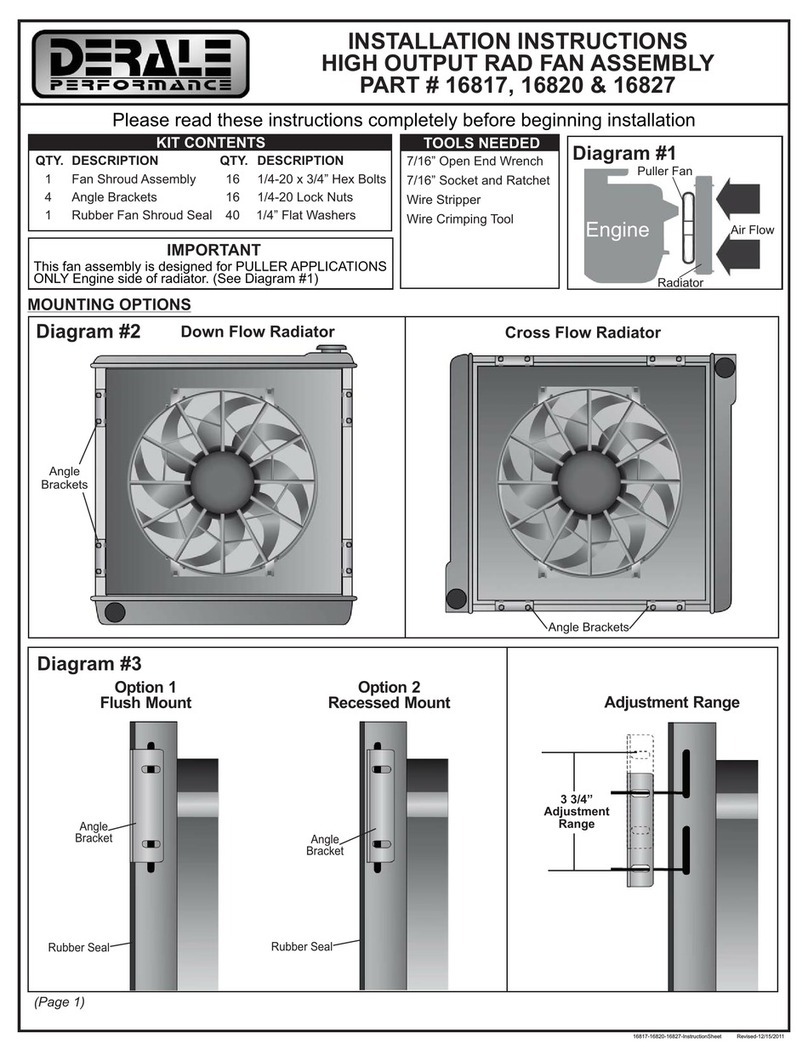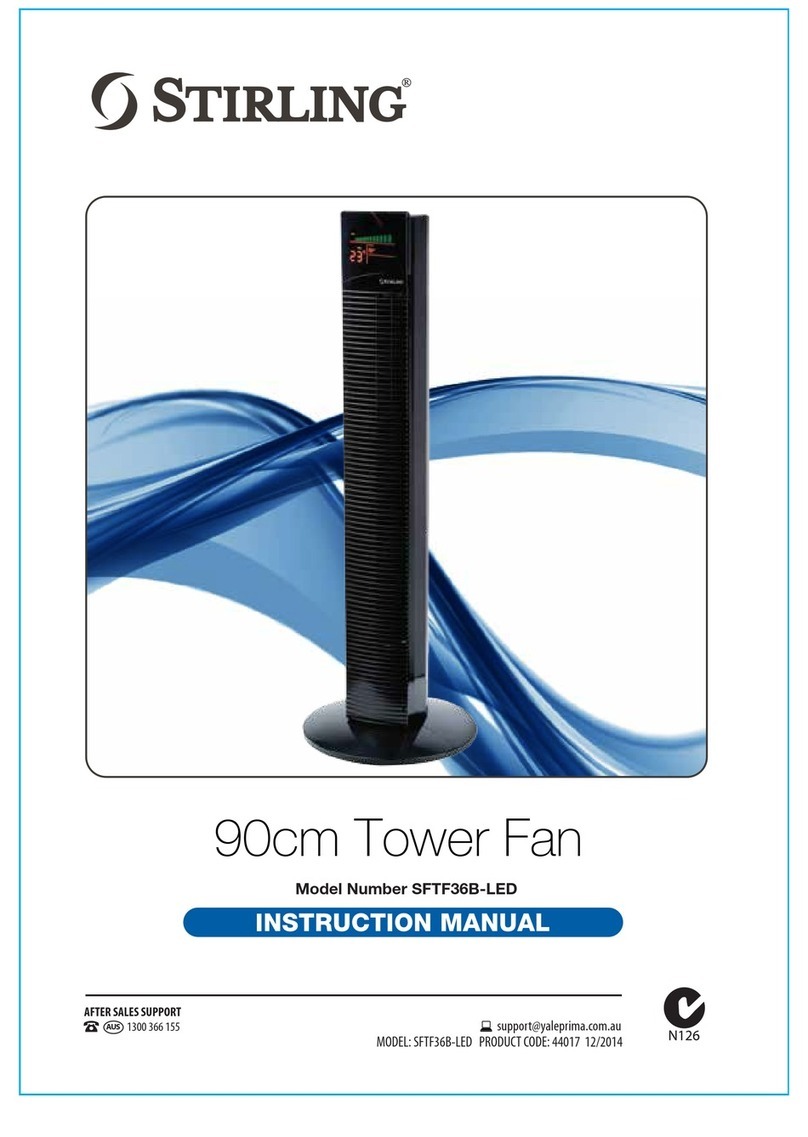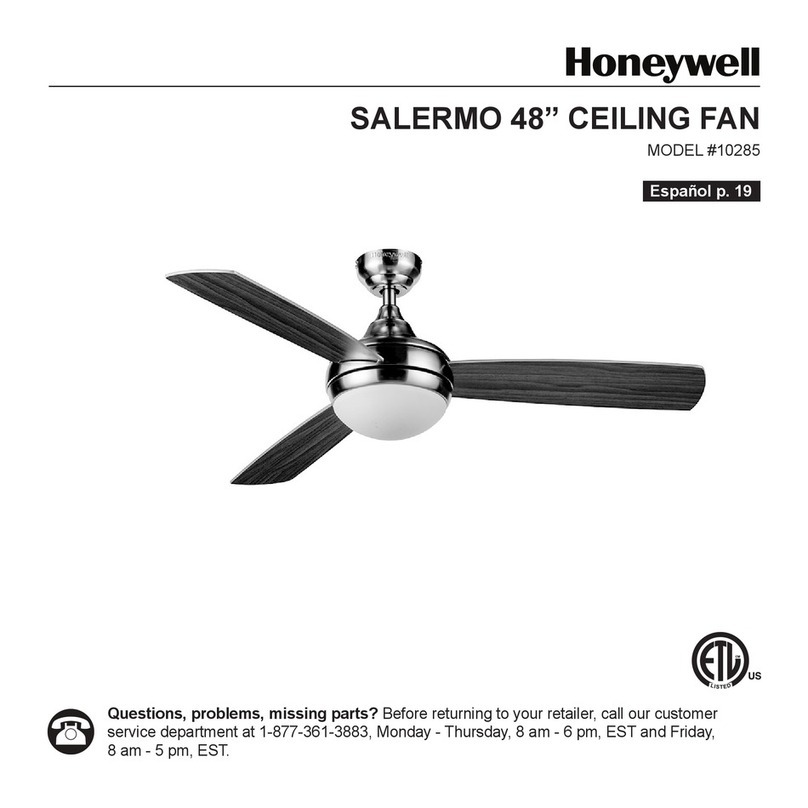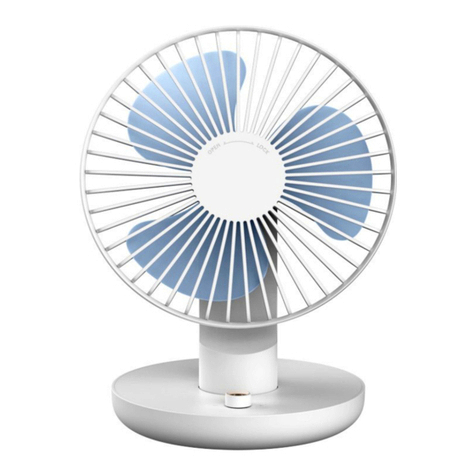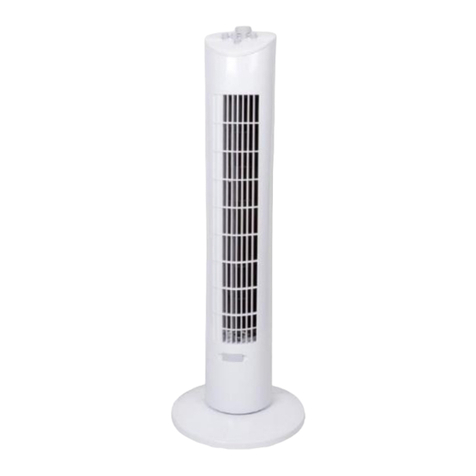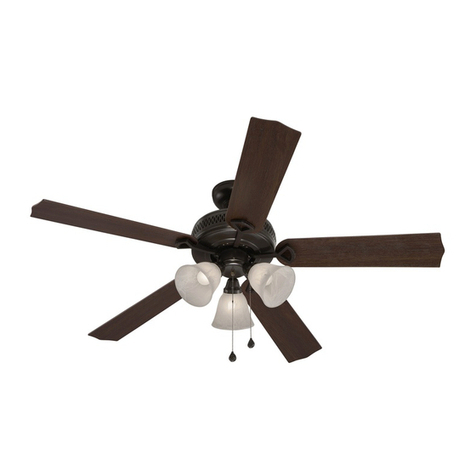NOVENCO Novax ACP Series Instruction Manual

1
916331-0
GB
MU14434 1110
Novax Axial Flow Fans Types ACP and ACG
Installation and Maintenance
1. Application
2. Handling
2.1 Marking
2.2 Weight
2.3 Internal transport
3. Storage
4. Assembling
4.1 Installation
4.2 Prior to attachment
4.3 Attachment
4.4 Mounting brackets
4.5 Duct connection
4.6 Wiring
5. Start of operation
5.1 Prior to start of operation
5.2 Motors with Y/ Δstarting
5.3 Starting procedure
6. Maintenance
6.1 Protection prior to inspection
andmaintenance
6.2 Fan casing
6.3 Impeller
6.4 Motor
6.5 Dismounting of motor
6.6 Mounting of motor
6.7 Blade pitch adjustment
6.8 Fault localization
7. Sound
8. Attestation of
conformity
1. Application
Axial flow fans types ACP and ACG are
compactandsturdystandardfans,suitable
for conventional installations for marine
and industrial ventilating applications.
2. Handling
2.1 Marking
The ACP and ACG fans areprovided with
a standard nameplate with Novenco's
name and address. It also mentions
producttype,e.g.ACP1000/380,serialNo.
or order No. as well as weight and fan
speed.
A motor nameplate with relevant motor
data is also provided.
2.2 Weight
The total weights shown in fig.1 and 2
apply to axial flow fans types ACP and
ACG.
Thetotalweightisdetermined onthebasis
of type/size of fan and the maximum
motor size employed, is in terms of kg.
The motor manufacture is ABB and the
data used apply to four-pole motors (fig.3).
2.3 Internal transport
Axial flow fans types ACP and ACG are
suppliedon palletsorbearerstoallowfork-
lift transport.
Fig. 2. Total weight for type ACG fans (incl. of motor).
Fan size Motor size
-71 -80 -90 -100 -112 -132 -160 -180 -200 -225 -250 -280
Hub diameters
160, 230, 280, 330 and 380
ACG 250 19,3 22,8
ACG 315 22,3 25,8 31,8
ACG 400 32,5 38 42 49,5
ACG 500 39,5 50 56 63,5 67 88
ACG 560 47,5 62 68 75,5 79 100 139
ACG 630 52,5 67 73 80,5 84 105 144 202
ACG 710 58,5 75 81 88,5 92 113 152 210
ACG 800 64,5 82 88 95,5 99 120 159 217
ACG 900 77,5 93 99 106,5 110 131 170 228
ACG 1000 108 115,5 119 140 179 237
Hub diameter
403 and 578
ACG 900 142 187 226 284
ACG 1000 153 219 258 316 361
ACG 1120 169 236 275 333 378 458
ACG 1250 282 321 379 242 504
ACG 1400 345 403 448 528 563
ACG 1600 487 567 602
Fig. 1. Total weights for type ACP fans (incl. of motor).
Fan size Motor size
-71 -80 -90 -100 -112 -132 -160 -180 -200 -225 -250 -280
Hub diameters
160, 230, 280, 330 and 380
ACP 250 15,6 19,1
ACP 315 17,5 21 27
ACP 400 24,5 28 34 41,5
ACP 500 28,5 38 44 51,5 55 76
ACP 560 35,5 48 54 61,5 65 86 125
ACP 630 38,5 52 58 65,5 69 90 129 187
ACP 710 43,5 58 64 71,5 75 96 135 193
ACP 800 48,5 63 69 76,5 80 101 140 198
ACP 900 57,5 71 77 84,5 88 109 148 206
ACP 1000 84 91,5 95 116 155 213
Hub diameter
403 and 578
ACP 900 112 154 193 251
ACP 1000 120 182 221 279 342
ACP 1120 132 195 234 292 337 417
ACP 1250 236 275 333 378 458
ACP 1400 294 352 397 477 512
ACP 1600 428 508 543
Fig. 3. The motor is of ABB manufacture (data for four-pole motors).
Motor type -71 -80 -90 -100 -112 -132 -160 -180 -200 -225 -250 -280
Motor weight 6,5 10 16 23,5 27 48 87 145 190 270 305 535

2
3. Storage
Axial flow fans type ACP and ACG can
stand outdoor storage for one month
provided the packing is intact. Fans with
no packing must be stored in a sheltered
place.
If the fans are stored indoors under well-
ventilated conditions with no risk of
condensation the storage period may be
extended to six months.
The storage space must not be exposed to
vibrations likely to damage the motor
bearings. If the storage period exceeds
three months, it is recommended to turn
the impeller regularly by hand.
4. Assembling
4.1 Installation
Novaxaxialflow fanstypesACP andACG
are designed for operation in both
horizontal and vertical position. (Know-
ledge of installation position is required
before drilling of drain holes).
ACP is for free inlet and without
connection to duct on the pressure side.
ACGis forfreeinletandconnectiontoduct
on the pressure side. (Downstream guide
vane arrangement).
4.2 Prior to attachment
Prior to attachment make sure that the
impeller rotates freely in the fan casing,
wherever possible with equal distance
between blade tip and fan casing
throughout the circumference.
4.3 Attachment
The fan is provided with an arrow-plate
denoting the direction of air flow through
the fan casing. See during installation that
the fan is oriented so as to provide the
desired direction of air flow in the system.
The best way of installing the fan is using
mountingfeet(availableasoptionalextras,
fig. 4), but it may also be suspended in the
fan casing flanges or in special carriers.
The carriers must not hamper the free inlet
and outlet flow of the air.
When the fan has been finally secured
makesurethattheimpellerrotatesfreelyin
the casing.
.
4.4 Mounting feet
Mounting feet for types ACP and ACG
consist of two mounting plates (fig. 4items
01 and 02). Mount two c-profiles (item 03)
undertheseby meansofbolts(item05)and
nuts (item 04).
The distance between the end of the c-
profile and mounting plates is determined
by type/size and motor size.
Mount the fan casing in the two flange
holesofthemountingplatesandmountthe
distance bush (fig. 5, item 07) by means of
joiningelements (items 08and09)between
inlet cone and mounting plate (item 06).
The fan houses for ACP and ACG sizes
1250 – 1600 have circular fan casings.
Therefore, the fan casing is mounted with
fittings for mounting foot (fig. 6 item 07A)
and joining elements (fig. 6 items 08A and
09A).
Mount the fittings on the back of the
mounting foot and fan casing as shown on
fig. 6.
To prevent vibrations spreading from the
fan to the surroundings, anti-vibration
mountings may be inserted between fan
andsupportand flexibleconnectionsfitted
in the ducts after the fan (available as
optional extra).
Secure anti-vibration mountings (fig. 5
item 10) in the ends of the c-profile by
means of bolts (item 11).
Mount base plates (item 12) for attachment
inthefoundation/flooratthebottomofthe
rubber element.
The natural frequency of the support must
differ at least 20% from the fan speed.
If the motor is provided with drain holes
for condensed water the fan must be
oriented so that the holes turn downwards
(lowest point).
Generally,itisoftheutmostimportancefor
the performance and sound level of an
axial flow fan that the air flow is
unimpeded and free from eddies.
4.5 Duct connection
A downstream guide vane arrangement
with core is mounted on the Novax axial
flow fan with which the fan obtains a very
high efficiency and is used for connection
to duct.
The duct on the fan outlet side must be
designed to ensure smooth and
undisturbed flow of the air; avoid, for
instance, sharp duct bends immediately
after the fan.
ACP and ACG fans are prepared for
circularductconnectionson theoutletside.
Flanges supplied as standard comply with
EUROVENT 1/2.
Systems with a higher vibration level or
more exacting performance requirements
must be provided with expansion joints
between fan and duct, and ducts must not
be supported by the fan.
It is important to allow for free areas to
facilitate mounting and dismounting as
well as ordinary maintenance.
Fig. 4. Mounting foot for type ACP
Fig. 5. Mounting foot for types ACP and
ACG 250-1120
Fig. 6. Mounting foot for types ACP and
ACG 1250-1600

3
4.6 Wiring
Connectiontothemainsiseffecteddirectin
the motor terminal box.
Connect 3-phase motors as shown on the
diagrams in the terminal box lid.
Regarding 1-phase motors see diagrams
for 1-phase adjustable motors.
Having wired the motor terminal box,
check that the direction of rotation of the
impeller complies with the arrow-plate
fitted on the outside of the fan.
For reversible fans (alternating directions
ofrotation)atime delayarrangementmust
be provided to ensure that the impeller is
stationary before restarting.
Important: Only fans with steel hubs
may be run in reverse.
Reversible operation
increases risk of fan
stalling. If the fan stalls, the
service life is shortened.
5. Start of operation
5.1 Prior to start of operation
Priortostartofoperation checkthatthefan
and duct connections are clean and free
from tools and foreign substances.
Also ensure that the electric connections
meettheprescribedrequirements,thatany
wire guard fitted on the fan inlet or outlet
side is correctly mounted and that the
direction of rotation of the fan complies
with the arrow-plate (check by short-time
operation).
See fig. 7 items 01 and 02.
5.2 Motors with Y/Δstarting
Therelaymustbeset to thecalculatedtime.
5.3 Starting procedure
• Start the fan.
• Check that no abnormal noises occur.
• See that the vibration level is normal.
The vibration level at the fan
operating speed must not exceed 7
mm/s, rms*, measured radially at
two points, 90° offset and at the free
shaftendofthemotor. Otherwise, the
fan must be balanced.
Operation at a vibration level exceeding 11
mm/s, rms*, is not allowed in case of fixed
fan position.
Operation at a vibration level exceeding 18
mm/s, rms*, is not allowed in case of
position on feet or anti-vibration
mountings.
* ISO 2954, Requirements for instruments
for measuring vibration severity.
Afterthirtyminutesofoperationcheckthat
the fan operates normally.
Important: The fan is designed for
continuous operation. The
following kinds of
operation may cause
fatigue break in the
impeller and endanger
people.
- Operation in stall area
- Operation with pulsating
counter pressure - called
pump mode
- Operation with repeated
starting and stopping
IfindoubtNovencoshould
be contacted to assess the
suitability of the fan.
6. Maintenance
6.1 Protection prior to
inspection and maintenance
Whenthefanisoutofoperationforreasons
of inspection or repair/maintenance, the
electric system must be switched off and
protected so that the fan is not cut in
unintentionally.
6.2 Fan casing
The fan casing requires as standard no
maintenance other than ordinary cleaning.
If the fan casing is painted, the painted
surface should be checked regularly and
repaired where necessary.
6.3 Impeller
The impeller (rotor unit) is supplied from
the factory with the blades adjusted to the
pitch corresponding to the desired
operating point (pressure and air flow) at
the fan speed in question. To ensure
vibration-free operation the impeller has
been carefully balanced in this position.
Vibrationsoccurringduringoperationwill
normally be due to accumulations of dust
or dirt on hub and blades, and will
disappearaftercleaning.Shouldthisnotbe
the case, expert assistance should be called
in immediately, as continued vibrations
will shorten the life of the blades and the
motor bearings.
6.4 Motor
The motor normally only requires
maintenanceofthebearingsasindicatedin
the maintenance instructions for electric
motors.
6.5 Dismounting of motor
Prior to commencing the work, switch off
thecurrentanddisconnectthemotorcable.
Next, dismount any ducts and
downstream guide vane arrangement (fig.
8 items 13, 10, 11, and 14) on the fan outlet
side.
Removetheimpeller centrescrew(item09)
and centre disc (item 08).
Dismounttheimpellerbymeansofapuller
fastened in the two threaded holes of the
hub boss (item 12).
Detach the motor by loosening the screws
in the motor shell (items 05 and 06). Now
the motor (item 01) and motor flange (item
02) can be removed.
Fig. 7. Novax Type ACG
Fig. 8. Dismounting/mounting of types ACG and ACP
1. Motor
2. Motor flange
3. Wire guard
4. Motor shell
5. S-washer
6. Set screw
7. Impeller
8. Centre disc
9. Centre screw
10. Set screw
11. Washer
12. Hub
13. Outlet guide vanes
14. Nut

Novenco A/S
Industrivej 22 Tel. +45 70 12 42 22
DK-4700 Naestved Fax +45 55 75 65 50
www.novencogroup.com [email protected]
4
In dismounting and disassembling the fan
be careful not to expose the individual
parts to shocks etc. likely to damage the
motor bearings or other fan components.
6.6 Mounting of motor
Afterservicing remountthemotor; seethat
the motor flange (fig.8, item 02) is correctly
located and that the motor shaft is
concentrically placed in the fan casing
before tightening the bolts (item 06).
Mount the impeller (item 07) on the motor
shaft by means of a tool fastened in the
threaded hole of the motor shaft. Fix the
impellerhubto restagainstthe motor shaft
collar. Check that the blade clearan-
ce is the same throughout the
circumferenceofthecasing.Ifthisisnotthe
case, adjust the motor location in the
suspension arrangement.
Now mount the centre screw (item 09) and
centre disc (item 08). Replace lock washers
and lock nuts during fan assembly. Finally,
connectthemotorcable intheterminalbox
(item 01) and any ducts and downstream
guide vane arrangement (item 13).
To start the fan follow the procedure
described in section 5 (Start of operation).
6.7 Blade pitch adjustment
The blade pitch has been adjusted in the
factory with a special tool (fixture) to
deliver the performance required by the
customer/order on delivery.
If the fan performance is required to be
changed it is possible to change the blade
pitch. It requires knowledge of the motor
load and the max. permissible blade pitch
on the graph as related to the motor rating
(in case of blade pitch increase).
Contact Novenco before any such
adjustment of the blade pitch.
Novenco cansupplyspecialtoolsforblade
pitch adjustment and instructions for
impeller balancing.
The brochure "Blade-angle tool" is
available on request.
6.8 Fault localization
These are likely causes of breakdowns/
failures:
Deficiency in performance:
Blocked air supply to the fan inlet side:
– Damper closed
– Duct choked
– Supply fan, if any, stopped
– Motordefective
– Motorcutout
– Wrong direction of rotation of impeller.
Noise/vibrations:
– Bearings in electric motor defective
– Impeller out of balance
– Impeller worn/damaged
– Bolts/components loose
– Impeller blades have different pitch
angles
– Fan operates in the stalling area. May
result in break-down - repair failures,
see "Deficiency in performance".
7. Sound
The sound generation of the fans depends
on installation and operating conditions,
which means that no general data of the
sound generation can be given.
Reference is made to our catalogues or
computer programs for calculation of the
specific sound generation.
8. Attestation of
conformity
EU - Attestation of Conformity
Novenco A/S
Industrivej 22
DK-4700 Naestved
Hereby declares that axial flow fans types
ACP 250-1600 and ACG 250-1600 have
been manufactured in conformity with the
Council's directive 2006/42/EC regarding
mutual approximation of the machinery
laws (the Machinery Directive) of the
member states.
Directives
– EC Machinery Directive 2006/42/EC
– EMC Directive 2004/108/EC
– Low Voltage Directive 2006/42/EC
Applied standards
EN ISO 12100-1:Safety of machinery part 1
EN ISO 12100-2:Safety of machinery part 2
EN ISO 13857: Safety of machinery -
Safety distances
EN 60204-1: Safety of machinery -
Electrical equipment of
machines Part 1 :
General Requirements
ItisaconditionthatNovenco'sinstructions
for installation have been followed.
Naestved, 1. 11. 2010
Steen Hansen
R&D manager
Novenco A/S
This manual suits for next models
29
Other NOVENCO Fan manuals
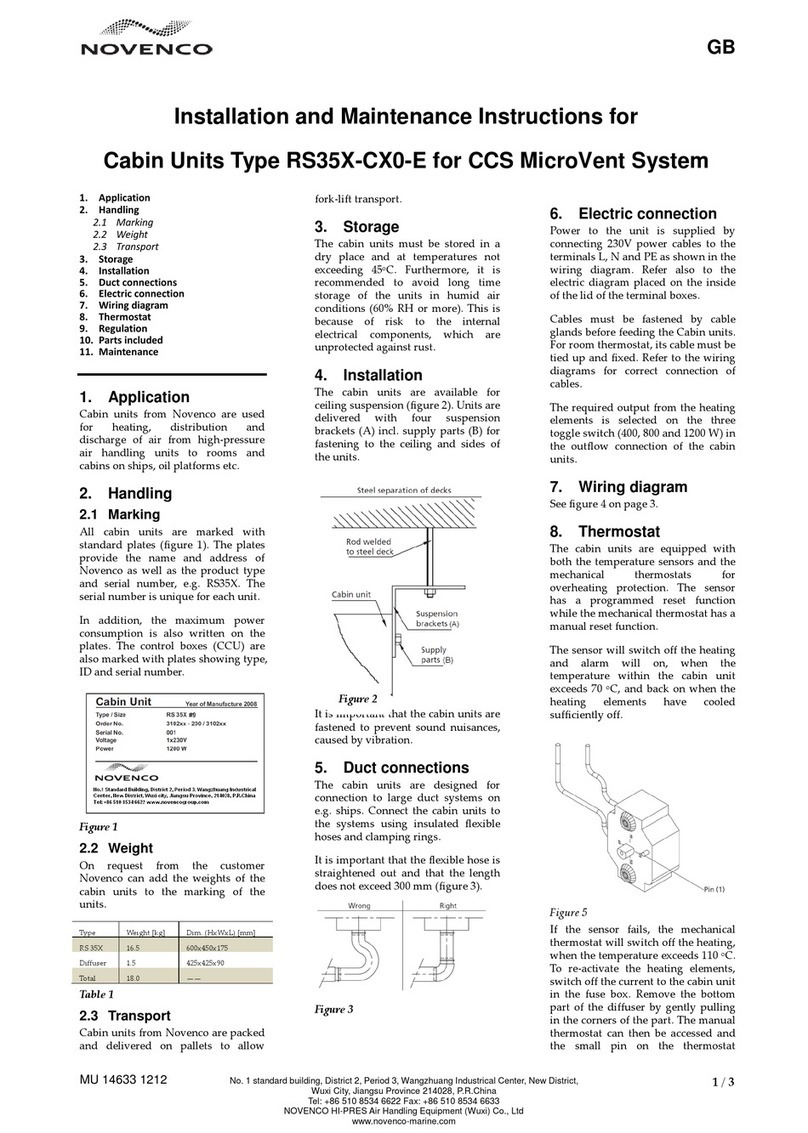
NOVENCO
NOVENCO RS35x-CX0-E series User manual
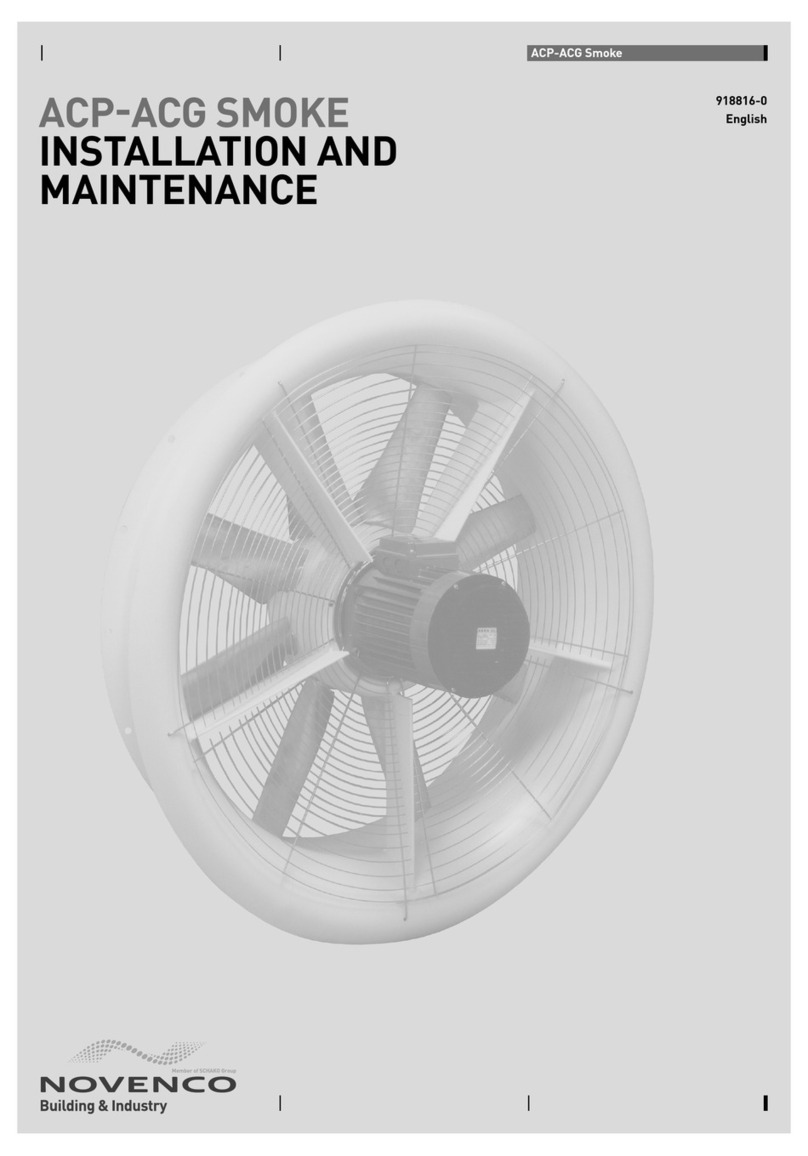
NOVENCO
NOVENCO ACP Series Instruction Manual

NOVENCO
NOVENCO FALKINN ACN Instruction Manual

NOVENCO
NOVENCO Novax Instruction Manual

NOVENCO
NOVENCO NOVAX ACN-ACW-ARN Instruction Manual
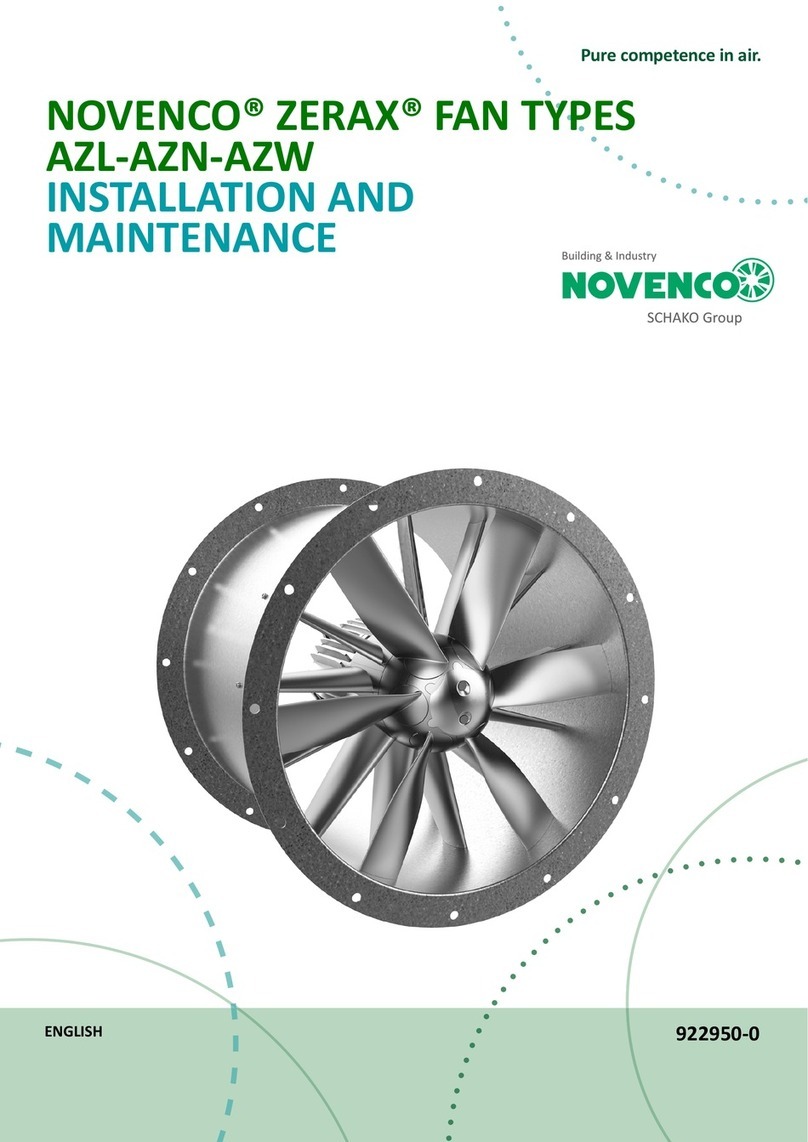
NOVENCO
NOVENCO ZERAX AZL-AZN-AZW Instruction Manual

NOVENCO
NOVENCO AUO 290 Instruction Manual
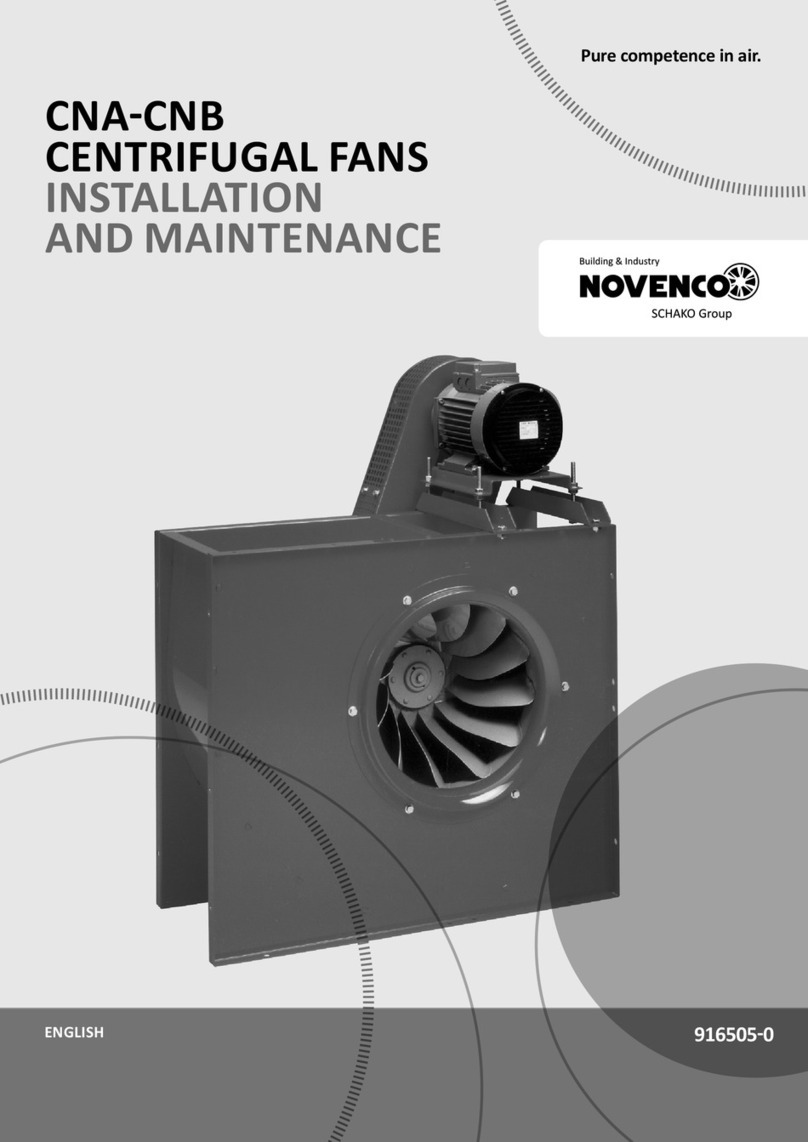
NOVENCO
NOVENCO CNA Series Instruction Manual


